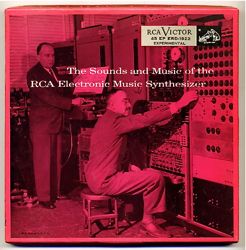 In 1955, RCA unveiled its Electronic Music Synthesizer, and a new era in the history of music began.
In 1955, RCA unveiled its Electronic Music Synthesizer, and a new era in the history of music began.
Developed at RCA’s David Sarnoff Research Center (near Princeton, NJ), it was the brainchild of Harry Olson and Herbert Belar. Olson was also the designer of a number of RCA’s microphones.
This huge and unwieldy system was controlled by a punched paper roll, similar to a player piano roll. A keyboard was used to punch the roll (Olson has his finger on it). Each note had to be individually described by a number of parameters (frequency, volume, envelope, etc.) The output was fed to disk recording machines, which stored the results on lacquer-coated disks. One of these can be seen at the left in the above photo.
The RCA Electronic Music Synthesizer caught the attention of electronic music pioneers such as Milton Babbit. A more advanced version of this system became the basis of the Columbia-Princeton Electronic Music Center in 1957, located at Princeton University.
As part of this development, RCA issued a box set of four 45 RPM extended-play disks, with a descriptive brochure. Here a listing of the contents of the disks:
Side 1: The Synthesis of Music-The Physical Characteristics of Musical Sounds (7:13, 3.3 mb)
Side 2: The Synthesis of Music-Synthesis by Parts (Part 1) (5:55, 2.7 mb)
Side 3: The Synthesis of Music-Synthesis by Parts (Part 2) (4:37, 2.1 mb)
Side 4: Excerpts from Musical Selections (Part 1) (6:05, 2.8 mb)
Side 5: Excerpts from Musical Selections (Part 2) (3:28, 1.6 mb)
Side 6: Complete Selections-Bach Fugue No. 2, Brahms Hungarian Dance No. 1 (4:47, 2.2 mb)
Side 7: Complete Selections-Oh Holy Night (Adam), Home Sweet Home (Bishop) (6:42, 3.1 mb)
Side 8: Complete Selections-Stephen Foster Medley, Nola (Arndt), Blue Skies (Berlin) (7:49, 3.6 mb)
The Reverse Time Page has digitized these historical synth recordings and has them available for download at their site.
You can preview the collection below, with Side 6: Complete Selections-Bach Fugue No. 2, Brahms Hungarian Dance No. 1.
